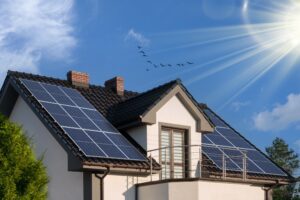Solar technology harnesses free, renewable energy from the sun to produce electricity that can power homes and businesses, and depending on the setup, provide hot water.
These two solar systems may appear similar but they work in different ways. Solar PV technology generates electricity, while solar thermal technology, which is generally less familiar, heats water.
It’s important to understand the differences between the two if you’re thinking about investing in solar technology, which captures electromagnetic radiation emitted by the sun and turns it into useful forms of energy.
You can find out here what you need to know about solar PV and solar thermal, including types of systems, costs, and savings on energy bills.
Solar PV Technology
Solar PV (photovoltaic) technology turns sunlight into electrical energy.Photovoltaic cells in solar panels soak up energy from sunlight. They’re made from a semiconductor material, usually silicon, that triggers an electrical charge and flow of direct current (DC) electricity.
Transistors in a solar inverter convert the direct current into an alternating current so it’s compatible with domestic electrical circuits and appliances.
PV cells are encased in protective glass or plastic so they can withstand the elements.
- Create a Tailored Quote Based On Your Circumstances
- Takes Less Than 2 Minutes
- Fixed-Online Quotes

Types of Solar PV Systems
There are three main types of solar PV systems: on-grid, off-grid, and hybrid.
On-Grid Solar PV Systems
On-grid solar PV systems (also known as grid-tied) connect directly to the national grid via a solar inverter. They’re the most common type of solar PV systems in homes and businesses and they help cut energy bills and mitigate carbon footprint by reducing reliance on the grid.
Any excess solar energy is fed back to the grid. You can get paid for this electricity through the Smart Export Guarantee (SEG).
A key benefit of an on-grid system is peace of mind that your energy supply will always be supported by the national grid.
On the other hand, if the grid fails, so will your solar system – you won’t have back -up power because on-grid systems use a grid-tied inverter.
Off-Grid Solar PV Systems
An off-grid solar PV system has no ties to the national grid. This can make it a good choice for households that can’t easily connect to the grid or want greater energy independence.
Off-grid solar systems can power homes in the remotest off-grid locations, providing energy self-sufficiency. Off-grid technology needs more components than a standard on-grid system. However, off-grid systems are modular, so you can build a system over time to meet your energy requirements.
Hybrid Solar PV Systems
A hybrid solar PV system is connected to the national grid but the energy it generates is first stored in a solar battery. Once you’ve used all the energy in the battery, you can draw power from the grid. The battery also provides a back-up power supply.
The main advantage of this system is that battery storage allows you to use your solar energy to power your home during the evening, so less is taken by the grid for use by someone else.
Unlike an on-grid system, your home will also have electricity during a power cut, drawing energy from battery supply. This is known as islanding, and is ideal for properties in areas prone to power outages.
Solar System Costs
Off-grid solar systems cost more than a standard on-grid system because they’re more complex. Hybrid systems are less expensive than an off-grid system but cost more than an on-grid system.
Types of Solar Panels
Decades of research and development have resulted in a broad range of different types of solar panels. These include monocrystalline solar panels, polycrystalline solar panels, thin-film solar panels, and third-generation solar panels.
Monocrystalline Solar Panels
Monocrystalline solar panels are the most commonly used for homes and the most efficient. They’re easily recognisable by their uniformly dark colour and rounded edges.
A mono solar cell is a single crystal of pure refined silicon, and it absorbs more sunlight than polycrystalline panels or thin-film solar panels. Monocrystalline panels can be designed to be even more energy efficient, with PERC (passivated emitter and rear contact) technology.
PERC systems have an extra layer on the rear surface of the standard silicon solar cell. This reflects back some of the sun’s rays into the solar panel.
Polycrystalline Solar Panels
Polycrystalline solar panels – also called poly panels or multi-crystalline panels – have a blue hue and straight edges. They consist of multiple silicon crystal fragments bonded together during manufacture.
With lower efficiency than monocrystalline cells, a polycrystalline solar system requires more panels to achieve the same power output.
Thin-Film Solar Panels
Thin-film solar cells – part of the second generation of solar power technology – comprise layers of semiconducting materials placed on a glass, plastic or metal substrate.
Thin-film solar panels are lighter and more flexible than other types of solar panels, which gives them a unique advantage. But thin-film solar cells are generally less efficient, needing a larger roof space to generate the same amount of energy.
Solar Panel Costs
Monocrystalline solar panels are usually the most expensive but can last 40 years or longer.
Polycrystalline panels cost around 20 per less than mono panels. On average, they last 25 to 30 years.
Thin-film solar panels are cheaper than other types of solar panels because they have fewer materials and are easier to install. But they don’t last as long – 10 to 20 years.
Third-Generation Solar Panels
Most third-generation solar panels are still at the research or development stage. These include concentrated PV cells and biohybrid solar cells
Concentrated PV Cells
Multi-junction concentrated PV (CPV) cells with curved mirrors and lenses boast a high efficiency and performance rate of more than 40%.
CPV panels use optics to focus sunlight onto ultra-thin photovoltaic surfaces. To achieve optimal performance, a solar tracker is used to ensure the system faces the sun at the right angle.
Biohybrid Solar Cells
Biohybrid solar cells aim to emulate the natural biological process of photosynthesis in which plants convert sunlight into energy.
The technology is being pioneered by the Vanderbilt private research university in the US.
Solar Thermal Technology
Although less well known than solar PV, products based on solar thermal technology came onto the UK market before photovoltaic systems.
Instead of converting solar energy into electricity, a solar thermal system harnesses the sun’s energy to provide hot water for homes.
It does this with mirrors that reflect concentrated sunlight onto solar thermal collectors – panels or tubes. These absorb the solar energy and turn the infrared light into heat.
The thermal energy is then directed to heat water for showers, baths, and kitchen and bathroom sinks. Larger solar thermal systems can also help meet a small percentage of home heating needs.
Solar thermal technology is simple and reliable and can be connected to a conventional boiler or immersion heater. During the summer, it could meet all or a substantial proportion of household hot water needs.
- Create a Tailored Quote Based On Your Circumstances
- Takes Less Than 2 Minutes
- Fixed-Online Quotes

Types of Solar Thermal Panels
Solar thermal panels are the water heating equivalent of solar photovoltaic panels and are around the same size.
They’re around 70% efficient, compared with the 15-20% efficiency of PV panels. This is because heat carries more energy than sunlight, and there’s no process of conversion into electricity.
Two types of solar thermal systems are commonly used: collectors with flat plates and collectors with evacuated tubes.
Solar Thermal Flat-Plate Collectors
Solar thermal flat-plate collectors are the most common type of solar thermal panels in the UK. Similar in appearance to solar PV panels, flat-plate collectors are enclosed in a transparent cover that solar radiation can pass through.
They consist of a thin metal sheet with a coating that absorbs solar energy. Fluid is pumped through tubes to transfer the resulting heat to a hot-water storage tank.
Flat-plate collectors are easy to manufacture and are low cost and low maintenance.
Solar Thermal Evacuated-Tube Collectors
Solar thermal evacuated-tube collectors consist of rows of parallel transparent glass vacuum tubes. They’re slightly more efficient than flat-plate collectors and can produce higher yields in spring and autumn, but they’re generally more expensive than flat-plate collectors.
Solar thermal evacuated-tube collectors may provide an option if roof space is limited – evacuated-tube collectors can be mounted on walls as well as roofs.
Solar PV Costs and Savings
The average cost of installing a solar photovoltaic system is around £7,000, ranging from about £2,350 for a one-bedroom-home to £11,000 for a four-bed house.
Solar PV panels cut energy bills by up to 70%, according to the Energy Saving Trust. With a solar battery storage system, that figure could be more like 90%, with sufficient solar energy to eliminate reliance on the grid completely during the summer.
Savings will increase further if you sell excess solar-generated electricity back to the national grid through the Smart Export Guarantee.
Solar Thermal Costs and Savings
Solar thermal systems are cheaper than PV panels, with installation costs typically ranging from £3,000 to £6,000. They’ll generally pay for themselves faster than PV panels, and they can work in cooler or overcast weather, and strong winds.
Solar thermal systems can meet domestic water heating requirements throughout the summer and make a significant difference during the rest of the year. This can save £1,350 over their lifespan.
They can provide 60% of domestic hot water needs. This can cut total energy costs by around 10%, with savings increasing over time as energy prices rise.
Combining Solar PV with Solar Thermal
Photovoltaic-thermal (PV-T) panels generate heat and electricity simultaneously. These hybrid solar panels can produce triple the amount of electricity and heat as regular solar PV panels and solar thermal panels.
Although still somewhat of a niche product, they’ve advanced considerably in recent years, using the sun’s light and warmth to provide a green, cost-effective way to power homes and provide hot water.
Solar PV-T panels combine two solar technologies: photovoltaics to absorb light, and a solar thermal component to capture the sun’s heat. This means you don’t have to install separate photovoltaic panels and solar thermal panels. And because these hybrid solar panels do two jobs, they save space.
Hybrid solar panels also increase energy output. Standard solar energy systems become less efficient in high temperatures. The design of PV-T panels cools the system.
Is Now the Right Time to Go Solar?
In the drive towards net zero, solar PV panels and solar thermal systems provide free, renewable energy that reduces carbon footprint and cuts the cost of electricity and heating water. Installing these solar technologies is a cost-effective long-term investment for householders, eventually paying for themselves as you use less grid energy and prices generally rise.
Today’s solar PV panels can last 30 to 35 years. Thermal panels can keep going for up to 25 years. Householders can get a solar PV or solar thermal system at zero rate VAT until March 31, 2027, when it will revert to the reduced 5% rate.
So now could be a good time to install solar PV panels and/or solar thermal panels, or a hybrid system.
Contact Effective Home to get a free site survey and customised solar energy installation plan for your home.
- Create a Tailored Quote Based On Your Circumstances
- Takes Less Than 2 Minutes
- Fixed-Online Quotes




